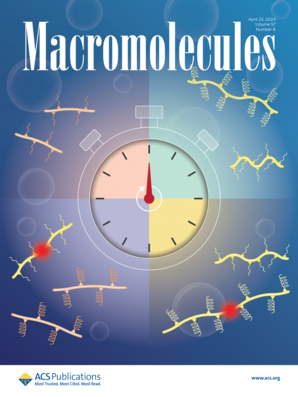Expanding the Toolbox of DNA Supramolecular Polymerization for Hyperbranched Nanopolymers
IF 5.1
1区 化学
Q1 POLYMER SCIENCE
引用次数: 0
Abstract
With the unique combination of polymer-like functionality and biologically inspired dynamics, supramolecular DNA nanopolymers have become a highly promising platform for engineering next-generation smart soft materials. Realizing their full functional potential requires expanding the architectural diversity of DNA nanopolymers in a manner akin to that of classical polymers. In this contribution, we present a remarkable advancement in the introduction of trivalent DNA nanostars with carefully designed sequences of sticky ends. Through the coarse-grained molecular dynamics simulations, it is revealed that the trivalent DNA nanostars have the capability to yield the hyperbranched nanopolymers with a tunable branching degree under one-pot programmable self-assembly. Importantly, extending the classical model of polymerization kinetics enables the quantitative prediction of the growth kinetics and branching degree of hyperbranched DNA nanopolymers, which can be tailored through the designed elements of trivalent DNA nanostars. Furthermore, the terminations of hyperbranched DNA nanopolymers are used as active sites to ligate the DNA-functionalized nanoparticles and yield the hierarchical coassemblies of branched nanoarchitectures, a previously unreported topology. We envision that the polymerization-like self-assembly of DNA nanostars will serve as a versatile platform for diversifying the topological architectures of supramolecular nanostructures, thereby advancing the broad applicability of DNA-based functional materials.

扩展DNA超分子聚合工具箱用于超支化纳米聚合物
超分子DNA纳米聚合物具有聚合物样功能和生物动力学的独特组合,已成为工程设计下一代智能软材料的一个非常有前途的平台。实现它们的全部功能潜力需要以类似于经典聚合物的方式扩展DNA纳米聚合物的结构多样性。在这篇文章中,我们介绍了在引入具有精心设计的粘端序列的三价DNA纳米星方面的显着进展。通过粗粒度的分子动力学模拟,揭示了三价DNA纳米星能够在一锅可编程自组装条件下生成支度可调的超支化纳米聚合物。重要的是,扩展聚合动力学的经典模型可以定量预测超支化DNA纳米聚合物的生长动力学和分支度,这可以通过设计三价DNA纳米星的元素来定制。此外,超支化DNA纳米聚合物的末端被用作连接DNA功能化纳米颗粒的活性位点,并产生分支纳米结构的分层共组装,这是以前未报道的拓扑结构。我们设想,DNA纳米星的聚合自组装将作为一个多功能平台,使超分子纳米结构的拓扑结构多样化,从而促进基于DNA的功能材料的广泛适用性。
本文章由计算机程序翻译,如有差异,请以英文原文为准。
求助全文
约1分钟内获得全文
求助全文
来源期刊

Macromolecules
工程技术-高分子科学
CiteScore
9.30
自引率
16.40%
发文量
942
审稿时长
2 months
期刊介绍:
Macromolecules publishes original, fundamental, and impactful research on all aspects of polymer science. Topics of interest include synthesis (e.g., controlled polymerizations, polymerization catalysis, post polymerization modification, new monomer structures and polymer architectures, and polymerization mechanisms/kinetics analysis); phase behavior, thermodynamics, dynamic, and ordering/disordering phenomena (e.g., self-assembly, gelation, crystallization, solution/melt/solid-state characteristics); structure and properties (e.g., mechanical and rheological properties, surface/interfacial characteristics, electronic and transport properties); new state of the art characterization (e.g., spectroscopy, scattering, microscopy, rheology), simulation (e.g., Monte Carlo, molecular dynamics, multi-scale/coarse-grained modeling), and theoretical methods. Renewable/sustainable polymers, polymer networks, responsive polymers, electro-, magneto- and opto-active macromolecules, inorganic polymers, charge-transporting polymers (ion-containing, semiconducting, and conducting), nanostructured polymers, and polymer composites are also of interest. Typical papers published in Macromolecules showcase important and innovative concepts, experimental methods/observations, and theoretical/computational approaches that demonstrate a fundamental advance in the understanding of polymers.
 求助内容:
求助内容: 应助结果提醒方式:
应助结果提醒方式:


